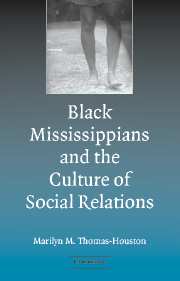Book contents
- Frontmatter
- Contents
- Preface
- Acknowledgments
- Introduction
- PART ONE THE CULTURAL HISTORY AND SOCIAL STRUCTURE OF THE REGION
- PART TWO SOCIAL CONSCIOUSNESS, SOCIAL ACTION
- PART THREE CONSTRUCTION OF AN INTRARACIAL IDENTITY
- Conclusion
- Appendix A Lafayette County Population Chart
- Appendix B Proclamation Honoring Ole Miss Demonstrators
- Appendix C Chancellor's Statement of Commendation
- Appendix D Speech by Susie Marshall for Second Baptist Church Honoring Rev. Blind Jim Ivy
- Appendix E Susie Marshall's Unpublished Draft of Freedman Town Marker Dedication Speech Recounting July 4, 1867, Speech of Oxford Ex-slave
- Bibliography
- Index
Conclusion
Published online by Cambridge University Press: 23 December 2009
- Frontmatter
- Contents
- Preface
- Acknowledgments
- Introduction
- PART ONE THE CULTURAL HISTORY AND SOCIAL STRUCTURE OF THE REGION
- PART TWO SOCIAL CONSCIOUSNESS, SOCIAL ACTION
- PART THREE CONSTRUCTION OF AN INTRARACIAL IDENTITY
- Conclusion
- Appendix A Lafayette County Population Chart
- Appendix B Proclamation Honoring Ole Miss Demonstrators
- Appendix C Chancellor's Statement of Commendation
- Appendix D Speech by Susie Marshall for Second Baptist Church Honoring Rev. Blind Jim Ivy
- Appendix E Susie Marshall's Unpublished Draft of Freedman Town Marker Dedication Speech Recounting July 4, 1867, Speech of Oxford Ex-slave
- Bibliography
- Index
Summary
African Americans struggle among themselves for the limited resources allocated to them under the systemic stratification of American society. As a result of these daily struggles, intraethnic interaction is negotiated on an event-by-event basis using varying cultural markers to control the level and effectiveness of that interaction. More often than not, this power-oriented process, a consequence of being on the lower end of American capitalism, not only perpetuates individualism and fragmentation but also contributes to varying forms of intraethnic division that support the hegemonic structure of the larger society.
The structure of African American society, however, does not require group homogeneity to operate as a unit. In times of need, varying segments of the larger group concerned with a specific issue will come together and form a social action unit. The degree to which they are successful depends not only upon the magnitude of cultural coherence but also upon the level of resistance exerted by elements of society responsible for producing and reproducing the social process or institution they are seeking to change. As for those who do not participate, I am reminded of a title from one of the first contemporary Black Broadway musicals (written, produced, and directed by African Americans), which pleads, “Don't Bother Me I Can't Cope.” One segment of nonparticipants perceives the specific goal of change as beyond their place and often envisions themselves as powerless against the larger society.
- Type
- Chapter
- Information
- 'Stony the Road' to ChangeBlack Mississippians and the Culture of Social Relations, pp. 176 - 194Publisher: Cambridge University PressPrint publication year: 2004

